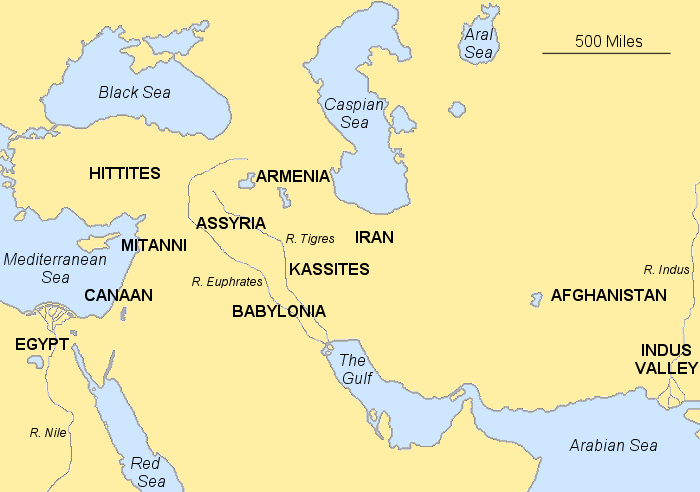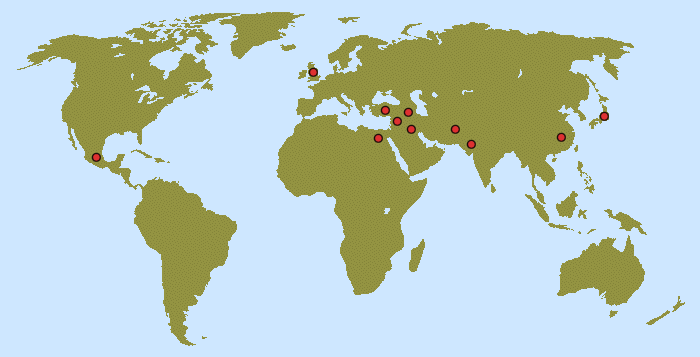Page 2 of 5
The End of Eden
Although civilizations had been established in various parts of the world since at least as early as 4000 BC, for over two millennia most remained relatively peaceful. Then, suddenly, around 1500 BC all this mysteriously changed. For a period of some two decades, around the world – in India, the Middle East, China, Japan, Europe and Central America - civilizations simultaneously began to fight amongst themselves or wage full-scale war on their neighbors, some ancient cultures being wiped out entirely by conflict.
The Mysterious Demise of the Megalithic Culture

The fate of the people who built Stonehenge is one of history's great unsolved mysteries.
Stonehenge in southern England is not only one of the world’s most famous ancient monuments, it is also one of the most enigmatic. Just why it was built is one of history’s most intriguing mysteries. An even greater mystery is what happened to the people who built it. Those who constructed this impressive monument were the Megalithic culture, a people who erected vast numbers of stone circles, some even bigger than Stonehenge, throughout the British Isles. As they had no form of writing, nothing is known of their beliefs or why they created these mysterious monuments, but archaeology has revealed that they began building them as early as 3500 BC.
The Megalithic people were remarkably peaceful. They left no evidence of organized warfare or tribal feuding, such as defensive structures, and the only weapons they manufactured were suitable merely for the hunting. Then, almost overnight in archaeological terms, everything changed. Carbon dating of human and animal remains has shown that sometime within a few decades of 1500 BC the Megalithic people abandoned their monuments, built defensive hill forts, and began to manufacture swords, battle axes and other weapons of war. As there is no evidence of foreign invasion, it seems that this peaceful 2000-year-old civilization suddenly tore itself apart.
The sudden demise of the Megalithic culture is mysterious enough, but it was just one of many civilizations around the world that suffered from a similar period of violence at precisely the same time.

The 13-foot-high Callanish Stones on the Isle of Lewis, one of the hundreds of mysterious monuments erected in the British Isles between 5500 and 3500 years ago.

Avebury stone circle in Wiltshire. At well over 1000 feet in diameter, almost ten times bigger than Stonehenge, it is Britain’s largest megalithic monument.
An Epidemic of Global Aggression

The civilizations of the Middle East and western Asia where conflicts erupted around 1486 BC.
When the pyramids were built around 2500 BC, Egyptian civilization had existed for over 500 years. During this time, and for the thousand years that followed, despite the fact that they were technologically far in advance of their neighbors, the Egyptians never attempted to build an empire. But for a short period that began in the year 1486 BC the pharaoh Tuthmosis III conducted a vicious campaign of military conquest. He marched his armies east into Canaan, what is now Israel and Lebanon, conquered Nubia to the south of Egypt and Libya to the west. At precisely the same time, almost every civilization across western Asia simultaneously and independently suffered a period of unprecedented violence. The Hittites of Turkey made pre-emptive strikes against their neighbors in Asia Minor. In Syria the kingdom of Mitanni attacked Assyria in what is now northern Iraq. The Kassites of the Zagros Mountains of southern Iran attacked Babylonia in southern Iraq. The Yaz people of Armenia invaded northern Iran. And the Harappan civilization in the Indus Valley of north-west India was attacked and wiped out by the tribes of Afghanistan.
Far away from the Middle East and western Asia large-scale conflicts and hostilities were also occurring on both sides of the Pacific Ocean. Civil war broke out in China, and in Japan the tribes of the Jomon people who had lived in peace for centuries began to pillage and burn each others' villages. Further away still, in Central America, the same story unfolds. Sometime around 1500 BC, the Pre-Olmec culture of Mexico came to an abrupt and mysterious end when towns, temples, and monuments were suddenly destroyed in what appear to have been mass tribal clashes.
A graphic portrayal of the brutality of Tuthmosis III’s campaigns still survives, recorded on the walls of Egypt’s Temple of Karnak at Luxor. The violence of the period is aptly demonstrated by the battle of Megiddo, fought between the Egyptians and Canaanites in what is now northern Israel. The fighting was so savage that the place name became synonymous with the word apocalypse. The biblical name for Megiddo was Armageddon.


Civilizations across the world that were simultaneously consumed by violence around 3500 years ago.
After around two decades this bizarre epidemic of global aggression final ended, but societies were forever changed. What could have caused civilizations throughout the world to simultaneously, suddenly, and independently become so aggressive? Scientists have suggested that some kind of short-term climate change might have been responsible by creating food shortages that led to conflict, but what caused such an abrupt climate change has so far remained a mystery. A vital clue, however, might be found in another strange synchronicity. The abrupt period of worldwide hostility was accompanied by the equally sudden emergence of astonishingly similar religious movements around the globe.








